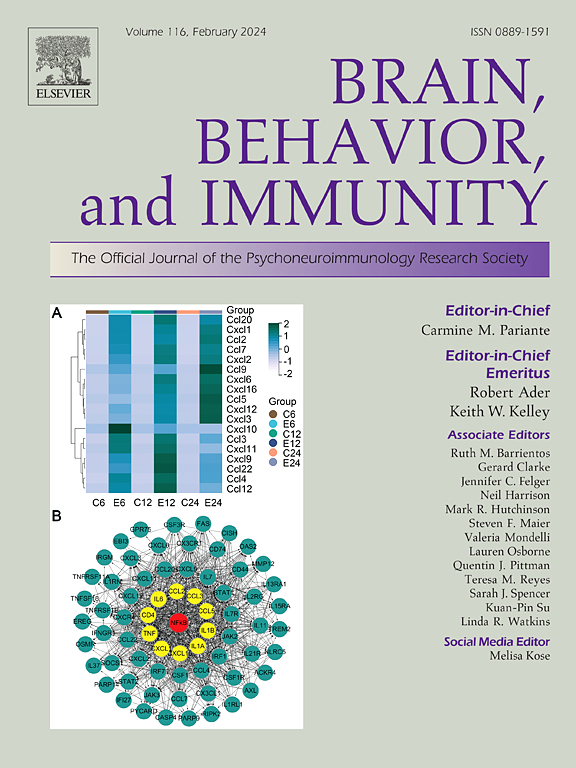Upregulation of delta opioid receptor by meningeal interleukin-10 prevents relapsing pain
IF 8.8
2区 医学
Q1 IMMUNOLOGY
引用次数: 0
Abstract
Chronic pain often includes periods of transient amelioration and even remission that alternate with severe relapsing pain. While most research on chronic pain has focused on pain development and maintenance, there is a critical unmet need to better understand the mechanisms that underlie pain remission and relapse. We found that interleukin (IL)-10, a pain resolving cytokine, is produced by resident macrophages in the spinal meninges during remission from pain and signaled to IL-10 receptor-expressing sensory neurons. Using unbiased RNA-sequencing, we identified that IL-10 upregulated expression and antinociceptive activity of δ-opioid receptor (δOR) in the dorsal root ganglion. Genetic or pharmacological inhibition of either IL-10 signaling or δOR triggered relapsing pain. Overall, our findings, from electrophysiology, genetic manipulation, flow cytometry, pharmacology, and behavioral approaches, indicate that remission of pain is not simply a return to the naïve state. Instead, remission is an adapted homeostatic state associated with lasting pain vulnerability resulting from persisting neuroimmune interactions within the nociceptive system. Broadly, this sheds light on the elusive mechanisms underlying recurrence a common aspect across various chronic pain conditions.
脑膜白细胞介素-10上调δ类阿片受体可预防复发性疼痛
慢性疼痛通常会有短暂的缓解期,甚至缓解期与严重的复发期交替出现。虽然大多数有关慢性疼痛的研究都集中在疼痛的发展和维持上,但更好地了解疼痛缓解和复发的机制仍是一项尚未满足的重大需求。我们发现,白细胞介素(IL)-10 是一种缓解疼痛的细胞因子,在疼痛缓解期间由脊髓脑膜中的常驻巨噬细胞产生,并向表达 IL-10 受体的感觉神经元发出信号。通过无偏见的 RNA 序列分析,我们发现 IL-10 能上调背根神经节中δ-阿片受体(δOR)的表达和抗痛觉活性。对IL-10信号或δOR的遗传或药物抑制都会引发复发性疼痛。总之,我们通过电生理学、遗传操作、流式细胞术、药理学和行为学方法得出的研究结果表明,疼痛的缓解并不是简单地恢复到天真状态。相反,缓解是一种适应性平衡状态,与痛觉系统内持续的神经免疫相互作用导致的持久疼痛脆弱性有关。从广义上讲,这揭示了各种慢性疼痛的共同点--复发--的难以捉摸的内在机制。
本文章由计算机程序翻译,如有差异,请以英文原文为准。
求助全文
约1分钟内获得全文
求助全文
来源期刊
CiteScore
29.60
自引率
2.00%
发文量
290
审稿时长
28 days
期刊介绍:
Established in 1987, Brain, Behavior, and Immunity proudly serves as the official journal of the Psychoneuroimmunology Research Society (PNIRS). This pioneering journal is dedicated to publishing peer-reviewed basic, experimental, and clinical studies that explore the intricate interactions among behavioral, neural, endocrine, and immune systems in both humans and animals.
As an international and interdisciplinary platform, Brain, Behavior, and Immunity focuses on original research spanning neuroscience, immunology, integrative physiology, behavioral biology, psychiatry, psychology, and clinical medicine. The journal is inclusive of research conducted at various levels, including molecular, cellular, social, and whole organism perspectives. With a commitment to efficiency, the journal facilitates online submission and review, ensuring timely publication of experimental results. Manuscripts typically undergo peer review and are returned to authors within 30 days of submission. It's worth noting that Brain, Behavior, and Immunity, published eight times a year, does not impose submission fees or page charges, fostering an open and accessible platform for scientific discourse.

 求助内容:
求助内容: 应助结果提醒方式:
应助结果提醒方式:


